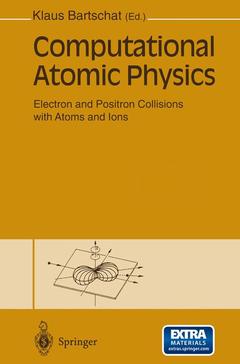Description
Computational Atomic Physics, Softcover reprint of the original 1st ed. 1996
Electron and Positron Collisions with Atoms and Ions
Coordinator: Bartschat Klaus
Language: English
Subject for Computational Atomic Physics:
Publication date: 08-2014
249 p. · 15.5x23.5 cm · Paperback
249 p. · 15.5x23.5 cm · Paperback
Description
/li>Contents
/li>Comment
/li>
Computational Atomic Physics deals with computational methods for calculating electron (and positron) scattering from atoms and ions, including elastic scattering, excitation, and ionization processes. Each chapter is divided into abstract, theory, computer program with sample input and output, summary, suggested problems, and references. An MS-DOS diskette is included, which holds 11 programs covering the features of each chapter and therefore contributing to a deeper understanding of the field. Thus the book provides a unique practical application of advanced quantum mechanics.
1. Electron-Atom Scattering Theory: An Overview.- Abstract.- 1.1 Introduction.- 1.2 Potential Scattering.- 1.3 Perturbation Approaches.- 1.4 The Close-Coupling Expansion.- 1.5 Computer Program for Potential Scattering.- 1.5.1 Description of the Input Data.- 1.5.2 Test-Run Data.- 1.6 Summary.- 1.7 Suggested Problems.- Acknowledgments.- References.- 2. Core Potentials for Quasi One-Electron Systems.- Abstract.- 2.1 Introduction.- 2.2 Theory.- 2.3 The Algorithm.- 2.4 Computer Program.- 2.4.1 Program Structure.- 2.4.2 Description of the Input Parameters.- 2.5 Test Run.- 2.6 Summary.- 2.7 Suggested Problems.- Acknowledgments.- References.- 3. Energies and Oscillator Strengths Using Configuration Interaction Wave Functions.- Abstract.- 3.1 Introduction.- 3.2 Hydrogen-Like Ions.- 3.2.1 Angular Momentum.- 3.2.2 Commuting Operators.- 3.2.3 Fine Structure.- 3.3 Two-Electron Atoms and Ions.- 3.3.1 Wave Functions for Two-Electron Ions.- 3.3.2 Variational Principle.- 3.3.3 Application to the Two-Electron Ground-State Energy.- 3.4 Many-Electron Atoms and Ions.- 3.4.1 Hartree’s Method.- 3.4.2 The Hartree-Fock Method.- 3.5 Configuration Interaction Methods.- 3.5.1 Optimization of the Expansion Coefficients.- 3.5.2 Optimization of the CSF.- 3.5.3 Correlation Energy.- 3.5.4 Choice of Configurations.- 3.5.5 Calculation of Several States Simultaneously.- 3.6 Transition Probabilities and Oscillator Strengths.- 3.6.1 Dipole Approximation.- 3.6.2 Length and Velocity Forms.- 3.6.3 The Effect of Electron Correlation.- 3.6.4 Selection Rules.- 3.7 The Codes.- 3.7.1 Running of the Codes.- 3.7.2 Sample Radial Data.- 3.8 Examples.- 3.9 Summary.- 3.10 Suggested Problems.- 3.10.1 He-Like Ions.- 3.10.2 Be-Like Ions.- 3.10.3 Ground State of Carbon.- References.- 4. The Distorted-Wave Method for Elastic Scattering and Atomic Excitation.- Abstract.- 4.1 Introduction.- 4.2 Theory.- 4.2.1 Distorted-Wave Series.- 4.2.2 Discussion of Distorting Potentials Ui and Uf.- 4.3 First-Order Amplitudes.- 4.3.1 Inelastic Scattering.- 4.3.2 Elastic Scattering.- 4.4 Partial-Wave Expansion of the T Matrix.- 4.4.1 Inelastic Scattering.- 4.4.2 Elastic Scattering.- 4.4.3 Differential Cross Sections.- 4.5 Computer Program.- 4.5.1 Radial Mesh.- 4.5.2 Numerical Technique.- 4.5.3 Program Input.- 4.5.4 Sample Input and Output.- 4.6 Summary.- 4.7 Suggested Problems.- Acknowledgments.- References.- 5. Distorted-Wave Methods for Ionization.- Abstract.- 5.1 Introduction.- 5.2 Theory.- 5.3 Reduction of the (e,2e) Amplitudes to Computational Form.- 5.3.1 Distorted-Wave Born Approximation: Direct Amplitude.- 5.3.2 Radial Partial Waves.- 5.3.3 Exchange Amplitude.- 5.3.4 Radial Integration.- 5.3.5 Distorted-Wave Impulse Approximation.- 5.4 Computer Program.- 5.4.1 Input.- 5.4.2 Calculation of the Differential Cross Section.- 5.4.3 Sample Input.- 5.4.4 Sample Output.- 5.5 Summary.- 5.6 Suggested Problems.- Acknowledgments.- References.- 6. The Close-Coupling Approximation.- Abstract.- 6.1 Introduction.- 6.2 Theory.- 6.2.1 The Close-Coupling Equations.- 6.2.2 Boundary Conditions and Cross Sections.- 6.3 The Numerical Solution of the Close-Coupling Equations.- 6.3.1 The Power-Series Expansion About the Origin.- 6.3.2 Asymptotic Correction Procedures.- 6.4 The Born Approximation.- 6.5 Computer Program.- 6.5.1 The Radial Meshes.- 6.5.2 Numerical Procedures.- 6.5.3 Convergence Criteria.- 6.5.4 Program Input.- 6.5.5 Sample Input and Output.- 6.6 Summary.- 6.7 Suggested Problems.- Acknowledgments.- References.- 7. The R-Matrix Method.- Abstract.- 7.1 Introduction.- 7.2 General R-Matrix Theory.- 7.3 Electron-Hydrogen-like Ion Scattering.- 7.4 Computational Solution of the Electron-Hydrogen-Like Ion-Collision Problem.- 7.4.1 The Inner Region.- 7.4.2 Outer Region Problem.- 7.5 Computer Program.- 7.5.1 Description of Input Data for the Program Package PACK1.- 7.5.2 Description of Input Data for PACK2.- 7.5.3 Sample Input and Output.- 7.5.4 Notes on Running the Codes.- 7.6 Summary.- 7.7 Suggested Problems.- Acknowledgments.- References.- 8. Momentum-Space Convergent-Close-Coupling Method for a Model e-H Scattering Problem.- Abstract.- 8.1 Introduction.- 8.2 Theory.- 8.2.1 Close-Coupling Equations.- 8.2.2 Target-State Manifold.- 8.2.3 Ensuring the Uniqueness of Solution.- 8.2.4 Momentum-Space Convergent-Close-Coupling.- 8.2.5 Cross Sections.- 8.3 Numerical Solution.- 8.3.1 Diagonalizing the Target Hamiltonian.- 8.3.2 Calculating V Matrix Elements.- 8.3.3 Solution of the Coupled Equations.- 8.4 Computer Program.- 8.4.1 Input.- 8.4.2 Output.- 8.4.3 Typical Usage.- 8.5 Summary.- 8.6 Suggested Problems.- References.- 9. The Calculation of Spherical Bessel and Coulomb Functions.- Abstract.- 9.1 Introduction.- 9.2 Spherical Bessel Functions.- 9.3 Recurrence Relations for Spherical Bessel Functions.- 9.4 Evaluation of the Continued Fraction.- 9.5 The Programs SBESJY and RICBES.- 9.6 Recurrence Relations for Coulomb Functions.- 9.7 The Program C0UL90.- 9.8 Test Data.- 9.8.1 Sample Input Data.- 9.8.2 Sample Output Data.- 9.9 Summary.- 9.10 Suggested Problems.- Acknowledgments.- References.- 10. Scattering Amplitudes for Electron-Atom Scattering.- Abstract.- 10.1 Introduction.- 10.2 Definition of the Scattering Amplitudes.- 10.3 Convergence of Partial Wave Expansions.- 10.3.1 Effective Range Theory for Elastic Scattering.- 10.3.2 Unitarized Born Approximation for Excitation.- 10.3.3 Exponential Fitting.- 10.4 Symmetry Properties of Scattering Amplitudes.- 10.5 Computer Program.- 10.5.1 Description of the Input Data.- 10.5.2 Test Runs.- 10.6 Summary.- 10.7 Suggested Problems.- Acknowledgments.- References.- 11. Density Matrices: Connection Between Theory and Experiment.- Abstract.- 11.1 Introduction.- 11.2 Scattering Amplitudes.- 11.3 Density Matrices.- 11.4 Irreducible Tensor Operators and State Multipoles.- 11.4.1 Basic Definitions.- 11.4.2 Coupled Systems.- 11.4.3 Time Evolution of State Multipoles: Quantum Beats.- 11.4.4 Time Integration over Quantum Beats.- 11.5 Observables.- 11.5.1 Generalized ST U Parameters.- 11.5.2 Generalized Stokes Parameters.- 11.6 2S ? 2P° Transitions.- 11.6.1 General Description of an Excited 2P° State.- 11.6.2 Relationship to Experimental Observables.- 11.7 Computer Program.- 11.7.1 Description of the Input Data.- 11.7.2 Test Run.- 11.8 Summary.- 11.9 Suggested Problems.- Acknowledgments.- References.
This book helps readers bridge the gap between theory and practice in the field of advanced quantum mechanics. Through the use of the samples and suggested problems, it provides practical computational methods for such tasks as calculating electron and positron scattering. The ten chapters, begin with an abstract and are followed by theory, a computer program with sample input and output and conclude with a summary. The computer program on the accompanying MS-DOS diskette enriches the presentation.
© 2024 LAVOISIER S.A.S.

